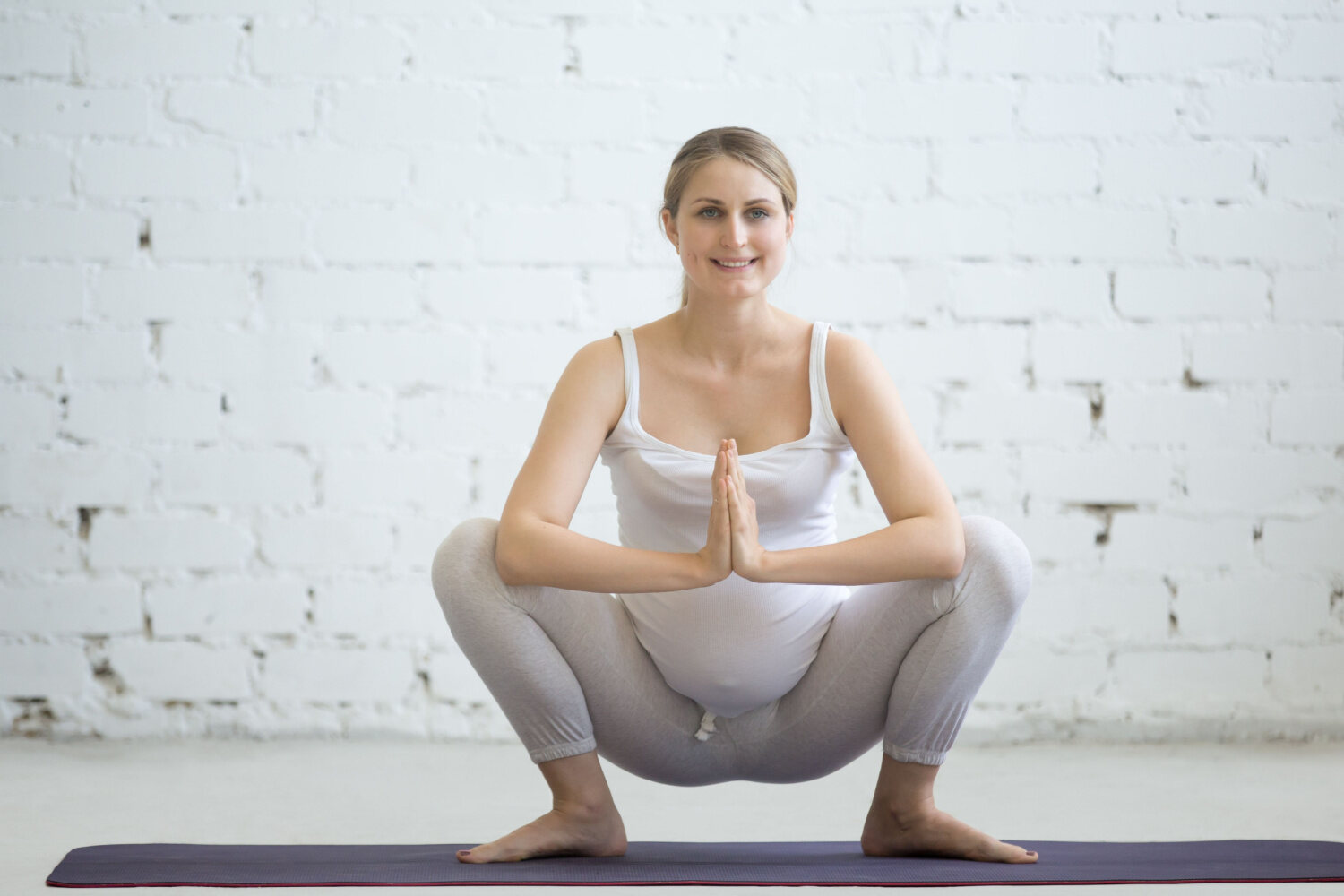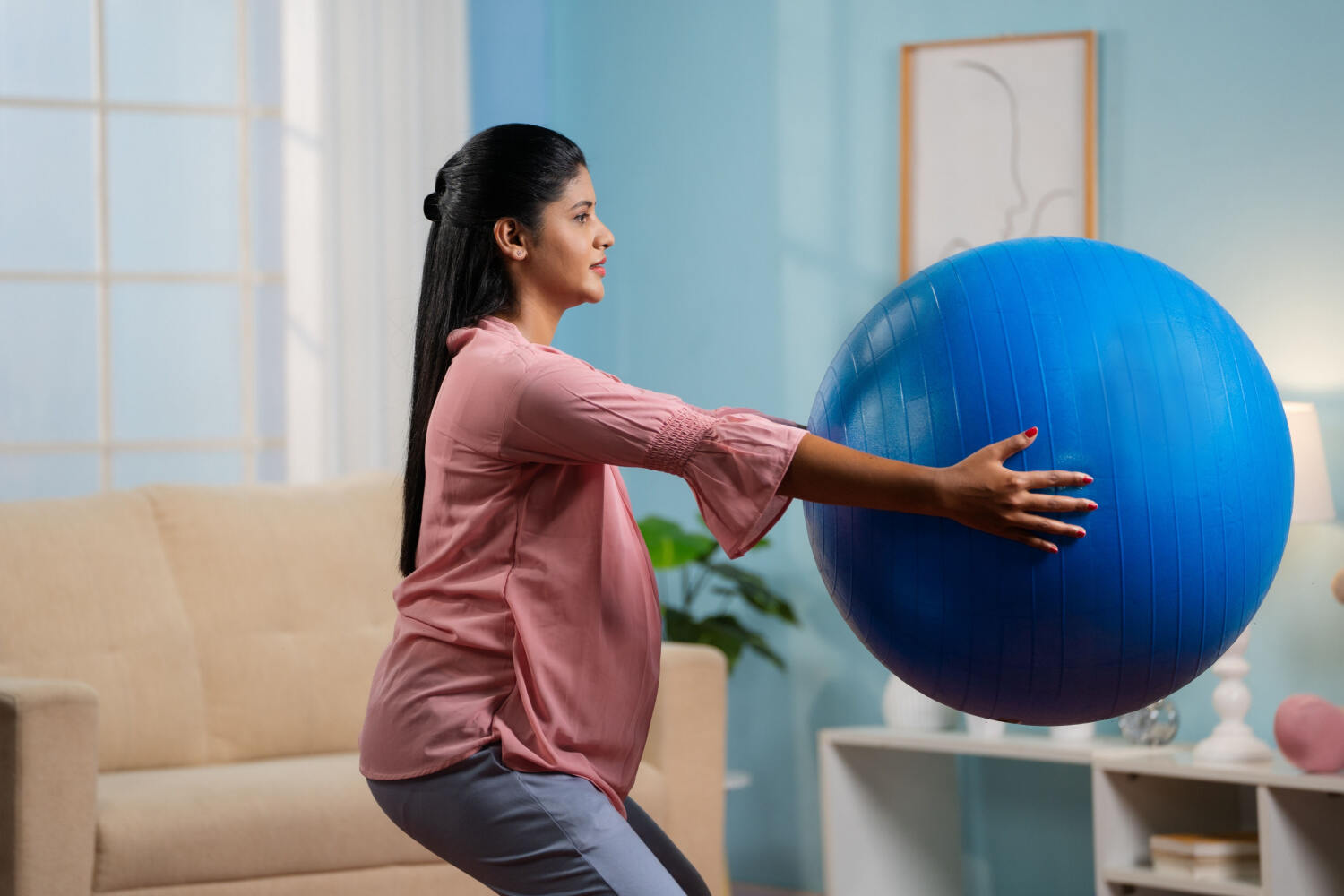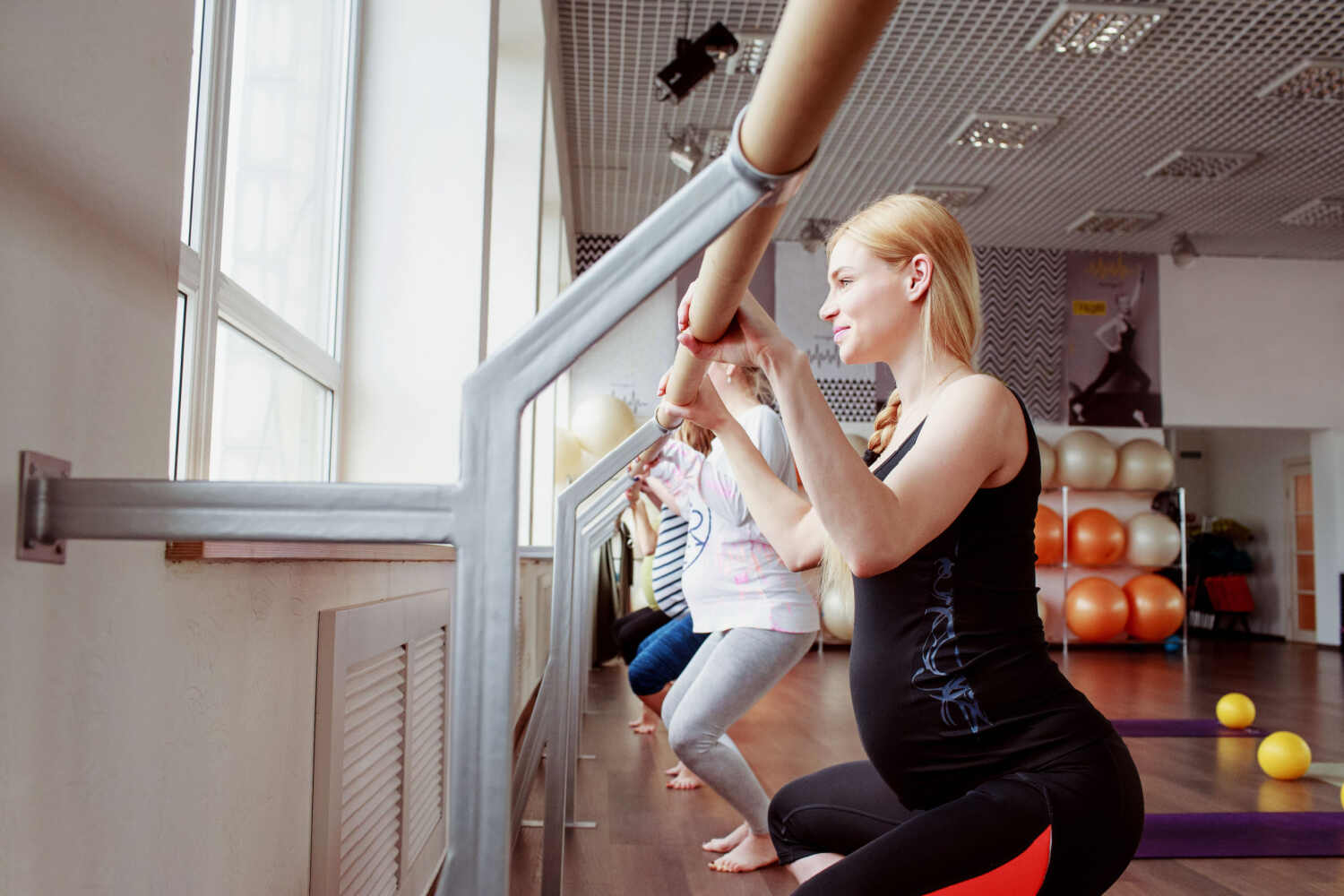
Pregnancy is a time to stay healthy and fit. A moderate and suitable workout routine helps improve pregnancy outcomes and also has a better impact on fetal well-being (1). Since the expectant mother is carrying, the only thing she should remember is to go slow, not do cardio, or exert too much. It is also said that when the mother exercises, the baby feels better too. However, a lot of people are not clear on what type of exercises should be done at this time. Doing squats during pregnancy provides strength to the lower part of the body and helps to keep it toned along with pumping the heart rate.
It is a good choice to make squats a part of the weekly schedule as it has its own set of advantages for the mother as well as the baby. Apart from that it even makes the process of labor and birthing smoother (2). Let us now study and find out how safe is it to squat during pregnancy, its advantages and when you should stop doing them.
Video on Squatting Guide For Pregnancy
Is it Safe to Do Squats During Pregnancy?
Squats are believed to be the safest and the ideal exercise that keeps one healthy and opens the pelvic area during pregnancy. Overdoing or getting into too heavy workouts can drain the energy of the expectant mother, which is not a good sign as that can lead to tiredness, irritation, etc. Being active is very important, as the body keeps getting the required fuel.
Before starting squats or before planning any fitness regime, it is highly recommended to consult the doctor so that he can assess your condition and give you the go-ahead. Squats ensure to strengthen the lower body and even enable proper movement of the core and pelvic muscles, the hips, etc. Not only that, the squats are excellent as they help to open the pelvis muscles, which is a great help during the process of normal delivery (3).
Benefits of Squatting During Pregnancy

Squats are the ideal choice to be done during the pregnancy phase if given a go-ahead by the doctor. These are good not only for the mother but also for the child. Let us see how it benefits the mother-child duo in brief. Some pointers for its benefits are (2A)
- Doing squats helps strengthen the glute muscles.
- Lower back pain is quite common in pregnancy and doing squats during pregnancy helps to relieve this pain that happens due to the loosening of ligaments.
- Squatting helps to smooth the functioning of the digestive system and even alleviates the issue of bloating, thus leading to the prevention of constipation.
- Squatting helps with the contractions that happen during labor as it helps to expand the birthing passage, letting the baby come out easily.
- It even relaxes the perineal muscles.
- If squatting is done in the last trimester, it strengthens the leg muscles, which helps to push the baby easily.
- The center of gravity that shifts during pregnancy can be maintained if squatting is practiced.
- Squatting is the best way to get rid of all pain and uneasiness, thereby keeping the expectant mother fit.
Top 8 Squats You Can Perform During Pregnancy
After knowing the benefits of squats, one also needs to know the different kinds of squatting exercises that are safe to do during the pregnancy phase. Given below are the types of squatting postures, but it is a good choice to consult with the doctor before starting them.
NOTE: All these exercises mentioned below should be modified according to your pregnancy’s bodily changes and must be done only under the supervision of your doctor and trainer (4).
1. Simple Squat
As indicative of the name, this is done simply without any equipment. They prevent or help reduce all types of pain and discomfort in the lower back portion of the body.
Process
- One needs to stand with feet shoulder-to-shoulder at a width apart and turn the feet in an outward direction to maintain balance.
- Put both arms in front with palms together.
- Now bend the legs in a deep squatting manner.
- Keep the palms open and press the knees with both hands to make space for the tummy.
- Bend towards the front side, keeping the balance intact.
- Hold in this position until comfortable.
2. Sumo Squats
Sumo squats help strengthen the thigh muscles and even open the hips.
Process
- Stand straight by keeping the feet wider than the shoulder, toes pointing out, and knees in sync with toes.
- Lower the body into a squatting position if comfortable.
- Knees should not concede to each other.
- Get back to the normal position by squeezing the glutes.
- Repeat this 10–15 times.
3. Dumbbell Squat
This type is good for strengthening the glutes and keeping the bottom in shape.
Process
- One needs to stand straight with feet and shoulders separate.
- Taking dumbbells in hands, one needs to stretch in front to maintain balance.
- Lower into a squat position if comfortable, ensuring that the back is straight, knees behind, or in sync with toes.
- Get back to the original posture and repeat this 10-15 times.
4. Barbell Squat
This type helps to strengthen the core muscles and enhance flexibility as well.
Process:
- Keep the barbell in front of the shoulder, and elbows in an outward direction.
- Bend the knees forward so that the hip can bend backward.
- Go down as if parallel to the ground level.
- Get back to the original position and repeat the same.
5. Box Set-Up Squat
This type of squat helps in strengthening the lower back, and quads.
Process
- As indicative of the name, a box needs to be put firmly on the floor.
- Now place the foot from the first leg on the box.
- Stretch and extend the knee of the right or left leg, whichever you wish to start with to be able to stand on the box.
- Now place the second as per your choice, left or right.
- Go down with the help of your second leg and get back to the normal position by placing the foot of your first leg.
- Repeat the same with others as well.
[Read: Top 5 Benefits of Kegels during Pregnancy]
6. Deep Squat With Pelvic Floor Contraction
Doing this type of squat helps to support the bladder, uterus as well and other organs. Muscles tend to become weak with passing time in pregnancy so to keep them active, squatting is a good choice as it enables the process of smooth delivery.
Process:
- One needs to stand in front of a wall with feet as wide as in a sumo squat pose.
- Bend the body without stretching much.
- Keep your arms in front of you or maintain the balance by holding the wall.
- Stand facing a wall with your feet in a wide sumo squat position.
- Once in this position, Kegel exercises need to be performed where the pelvic muscles must be stopped in a manner that stops the urge to urinate, this process strengthens the muscles of this area, making labor and delivery smooth.
- Hold the posture for a few seconds and get back to the original position.
- Repeat at least five to seven times.
7. Squats Aligned With Wall Using Exercise Ball
The core muscles gain strength during this type of squat.
Process:
- We need to stand straight, back intact, or leaning against a wall.
- Now keep an exercise ball between the lower back and the wall.
- Now place the feet and shoulder at a width, not together.
- Stretch the arms in front to maintain balance.
- Bend down as much as at ease.
- Get back to normal position and repeat for 10-15 sittings.
[Read: Exercise Ball During Pregnancy]
8. Chair Squats
It is also referred to as half-chair squats and is advisable for women who do not feel comfortable with the regular squat position.
Process:
- One needs to stand straight with feet and shoulders at width, not together.
- Now sit slowly in the chair with the hips resting on it for a few seconds.
- Stand back again in the original pose taking the help of the glute muscles.
- Once at ease, the duration can be increased from 15 to about 60 seconds.
- Repeat for 10-15 sittings.
Besides the ones mentioned before, some squats can even be done with the help of equipment during pregnancy. The only thing to remember is that consultation with a doctor is a must as he can assess the condition of the expectant mother and then take a call and recommend the ones that are suitable for her.
How Does Physical Changes During Pregnancy Affect Squats?

Squatting can be started as early in pregnancy as possible but with doctors’ consent. It is, however, seen that as the pregnancy progresses, the size of the tummy changes and so does the body (4A). So, it is advisable to make the necessary changes to the exercise schedule as per the changes in the body.
The hormones, especially relaxin produced during pregnancy can lead the joint ligaments to stretch resulting in more injuries (5). The body weight also increases shifting the center of gravity and if using any equipment, there is an additional weight that is exerted on muscles and joints of the pelvic area as well as the lower back resulting in imbalance. It is thus important to follow a few basic pointers while doing squats during pregnancy.
How Often Should You Squat During Pregnancy?
With your doctor’s permission, you can incorporate squatting exercises into your daily routine, even when you are expecting. You may also want to include squatting into your day-to-day activities like using squatting to pick up items that have fallen on the floor or reaching out for things on lower shelves to make it easier for you as your tummy gets bigger. The more often you squat, the more beneficial it is during birthing.
Basic Guidelines to Follow While Doing Squats

To have a proper balance and be safe during the phase of pregnancy, a few tips that should be borne in mind while performing squats in pregnancy are as below
- The workout can be intense in the first trimester if the body is fine with it, also increasing the number of times to be done.
- The intensity of the workout in the second trimester should be not too high since the tummy grows with time as well. Never attempt to do difficult exercises (6).
- If need help to maintain the balance of the body, never hesitate for help.
- Increase the consumption of water and keep hydration as the prime focus. Always carry a bottle and take water while working out.
- Never wear tight clothes and opt for loose and cotton clothes through which you can breathe and even help in the prevention of sweating while exercising.
- Always wear a good quality maternity bra that offers additional support to the breast while exercising.
- Always opt for anti-skid soles and properly fitting shoes that do not hurt the toes and do not result in any falls.
- Do not exercise until the level of exhaustion.
- Always exercise on a flat surface to prevent falling or sipping.
- Squats should not be performed immediately after a meal and a gap of an hour or two should be given, also should not be performed without eating anything.
What Are The Disadvantages Of Squats During Pregnancy?
Squatting is beneficial for uncomplicated pregnancies and only if done under proper supervision. But, there are a few disadvantages associated with squatting during pregnancy.
- Pregnant women who perform squats without proper form may encounter knee discomfort.
- Failure to maintain a straight back with a slight anterior inclination may result in the occurrence of back pain.
- Research has indicated that performing deep squats may potentially elevate the likelihood of developing hemorrhoids, a low-lying placenta, and low umbilical cord vessels.
- It may result in a breech position of the fetus.
- Excessive squatting during the late stages of pregnancy (between weeks 34 and 38) has the potential to impact the engagement of the fetus, which could potentially lead to a posterior presentation.
When Should You Not Squat?

Squatting no doubt is a great and healthy option to be fit but pregnancy is a time when overexertion and doing wrong things could lead to problems. So, given below are certain conditions under which squatting should be avoided and these are:
- When the baby does not reach the optimal position even after 30 weeks. In case the baby is not in a position where the head is not down, doing squats is not a good idea. Squatting can push the bottom of the baby towards the pelvis leading to an unfavorable position, in case the baby gets back to the head-down position, squatting can be resumed.
- While doing squats, in case one experiences pain, then it should be stopped immediately. It is ideal to discuss with the doctor beforehand (6A).
- If the expectant mother is undergoing any complications in pregnancy like placenta previa, low placenta, chances of preterm labor, more than one pregnancy, etc then squatting might not be a good idea as labor can get induced earlier.
[Read : Can Squats Help To Induce Labor?]
Can Squats Induce Labor?
Squats are known to induce labor as they help in opening the pelvic floor muscles and even strengthen them (2B). This pelvic opening offers much room to the baby and it can easily descend towards the uterus, which can lead to cervix dilation resulting in inducing labor.
A few more instances are listed below
- When squatting, more room gets created for the baby, making his descent easy towards the birthing area.
- Women who deliver in a squatting position can avoid the third or second degree of perineal tears and need fewer instruments to be used for delivery, especially the forceps.
Thus, starting from the initial stages of pregnancy till delivery, squats are helpful at all stages except the special medical conditions that have been mentioned above. This eases the labor and the birthing process. One should always go slow, starting with light exercises and then heading to the difficult ones gradually increasing the intensity. The most important, however, is to be comfortable so look out and perform to only the level where the body feels comfortable.
FAQ’s
1. Should I Squat During Pregnancy?
If you have been an exercise enthusiast, it is always considered good and healthy to continue exercising during pregnancy. However, you should always modify exercises according to the pregnancy’s bodily changes. Squats play a very important role in opening the pelvic area and help in easing labor.
2. Can Squatting During Pregnancy Cause Labor?
Modified squatting during the period of pregnancy can only help in strengthening the pelvic area. However, squatting position during labor can help in reduced medical interventions, vaginal tears during labor (7).
3. Is it Safe to Squat in the First Trimester?
It is very important to consult your doctor regarding squatting during the first trimester. If you are physically active, your doctor might not ask you to stop.
4. Can I do Full Squats When Pregnant?
Studies claim that squatting helps in easing child birth, especially if you are used to it. However, if you have never exercised before pregnancy, it is important to consult your doctor, they can help you guide on proceeding with such exercises during pregnancy.
References
- Exercise in Pregnancy – [https://www.ncbi.nlm.nih.gov/pmc/articles/PMC4622376/]
- Squatting, pelvic morphology and a reconsideration of childbirth difficulties – [https://www.ncbi.nlm.nih.gov/pmc/articles/PMC9154243/]
- The effects of squatting while pregnant on pelvic dimensions: A computational simulation to understand childbirth – [https://pubmed.ncbi.nlm.nih.gov/30851977/]
- Physical Activity and Exercise During Pregnancy and the Postpartum Period – [https://www.acog.org/clinical/clinical-guidance/committee-opinion/articles/2020/04/physical-activity-and-exercise-during-pregnancy-and-the-postpartum-period]
- The Main Changes in Pregnancy—Therapeutic Approach to Musculoskeletal Pain – [https://www.ncbi.nlm.nih.gov/pmc/articles/PMC9414568/]
- Guidelines for Physical Activity during Pregnancy: Comparisons From Around the World – [https://www.ncbi.nlm.nih.gov/pmc/articles/PMC4206837/]
- Child birth in squatting position – [https://pubmed.ncbi.nlm.nih.gov/17319414/]
Read Also: Prenatal Pilates Exercises Safe During All Trimesters
